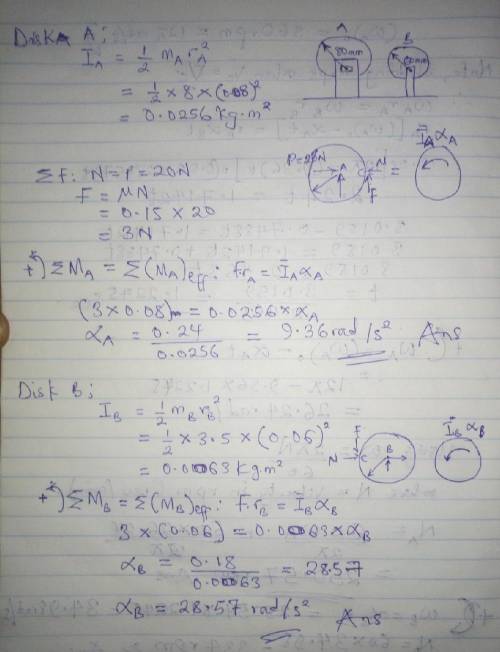
Engineering, 21.04.2020 01:43 david7962
Disk A has a mass of 8 kg and an initial angular velocity of 360 rpm clockwise; disk B has a mass of 3.5 kg and is initially at rest. The disks are brought together by applying a horizontal force of magnitude 20 N to the axle of disk A. Assume that μk = 0.15 between the disks. Neglect bearing friction.
Required:
Determine:
a. the angular acceleration of each disk.
b. the final angular velocity of each disk.

Answers: 1
Another question on Engineering

Engineering, 04.07.2019 18:10
During a steady flow process, the change of energy with respect to time is zero. a)- true b)- false
Answers: 2

Engineering, 04.07.2019 19:20
Acompressor compresses a gas, a pump compresses a liquid. for a given pressure ratio, why does it take more work to compress a gas in a compressor than a liquid in a pump? a)- for a given pressure ratio the average specific volume for a gas is much higher than the average specific volume for a liquid. b)- there is no difference. the only difference is the amount of heat generated (not work) c)- for a given pressure ratio the average volurge for a gas is much higher than the average volume for a liquid. d)-there is no difference
Answers: 3

Engineering, 06.07.2019 03:10
Air is flows through an adiabatic nozzle with an inlet pressure of 400 psia at a temperature of 300°f and a velocity of 20 ft/s. the outlet pressure is 40 psia and the velocity is 800 ftl/s. determine the outlet temperature of the air using: a) property tables b) specific heat (using the specific heat value for air at 300°f)
Answers: 3

Engineering, 06.07.2019 04:10
Aspherical thermocouple measurement errors a spherical thermocouple made of constantin transfer coefficient between the gas and the thermocouple is h used to measure the temperature of a gas. the heat 400 w/m2 k. calculate the maximum diameter d of the thermocouple if the thermocouple's measurement error should be w 23 within 5% of the initial temperature difference in 5 seconds. for constantin, k 8920 kg/m3, and c 410 j/kg. k.
Answers: 3
You know the right answer?
Disk A has a mass of 8 kg and an initial angular velocity of 360 rpm clockwise; disk B has a mass of...
Questions


Mathematics, 13.02.2020 19:47




English, 13.02.2020 19:47

History, 13.02.2020 19:48

English, 13.02.2020 19:48

Mathematics, 13.02.2020 19:49


Social Studies, 13.02.2020 19:49

English, 13.02.2020 19:50


Mathematics, 13.02.2020 19:51

Mathematics, 13.02.2020 19:52




Mathematics, 13.02.2020 19:52





